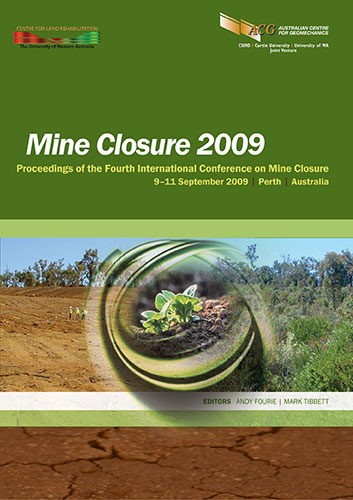An evolution of the methods for and purposes of mine closure cost estimating

|
Authors: Parshley, JV; Bauman, W; Blaxland, D |
DOI https://doi.org/10.36487/ACG_repo/908_13
Cite As:
Parshley, JV, Bauman, W & Blaxland, D 2009, 'An evolution of the methods for and purposes of mine closure cost estimating', in AB Fourie & M Tibbett (eds), Mine Closure 2009: Proceedings of the Fourth International Conference on Mine Closure, Australian Centre for Geomechanics, Perth, pp. 187-200, https://doi.org/10.36487/ACG_repo/908_13
Abstract:
The last two decades have seen a significant evolution in both the methods for and purposes of closure cost estimating. As part of this evolution, changes in the uses of closure cost estimates have resulted in coincident changes in the scope, methods employed and level of detail required. Prior to the development of regulatory requirements to prepare closure cost estimates, closure cost estimates were typically intended for planning, design and contracting of the actual closure, and were often developed late in the mine life cycle. The level of detail required was largely determined by the number of years remaining in the operational life of the mine at that time. The nearer to the time of closure, the more detailed the closure design and cost estimate became. These closure designs became the basis for construction contract bidding and tracking purposes. As mining laws changed and the need to provide financial surety for closure activities became a priority, the focus of closure cost estimating in many countries was to reduce the liability of the government that would assume responsibility should the operator abandon the site prior to planned closure. The latest evolution of closure cost estimating techniques has been focussed on improving closure cost estimating for the purpose of accurate reporting of financial liabilities to shareholders, lending institutions and governments. Requirements for reporting mine closure liabilities have added a new dimension to the scope and detail of closure cost estimating. This paper documents the history of mine closure cost estimating since the 1970s and discusses the influence that different purposes for mine closure cost estimates have had on the evolution of methods used to develop those estimates. Several examples of successes and failures in closure cost estimates for actual mine sites and the regulatory programmes that oversee the closure of these mine sites are presented as illustrations of the progression of closure cost estimating and demonstrate the importance of this discipline in the mining life cycle process. Current trends in the current best practice and their probable impact on the future of closure cost estimating are also discussed.
References:
International Accounting Standards Board (IASB) (2004) Notes from IASB Board Meeting 18–19 May 2004, London,
p. 5.
Miller, C.G. (2005) Financial Assurance for Mine Closure and Reclamation: A study prepared for the International
Council on Mining and Metals (ICMM), London, p. 67.
An evolution of the methods for and purposes of mine closure cost estimating J.V. Parshley et al.
200 Mine Closure 2009, Perth, Australia
New South Wales Department of Primary Industries (NSW–DPI) (2005), Mineral Resources EDP11 Rehabilitation
security deposits policy, 1 p., viewed 20 June 2009,
11.pdf
New South Wales, Department of Primary Industries (NSW–DPI) (2006), Mineral Resources Division, ESB20,
Rehabilitation Security Deposit Requirements for Mining and Petroleum Titles, 17 p., viewed 20 June 2009,
Requirements-for-Mining-and-Petroleum-Titles.pdf.
Parshley, J.V. and Struhsacker D.W. (2009), The Evolution of Federal and Nevada State Reclamation Bonding
Requirements For Hardrock Exploration And Mining Projects: A Case History Documenting How Federal and
State Regulators Used Existing Regulatory Authorities to Respond to Shortcomings in the Reclamation Bonding
Program, Northwest Mining Association, 7 p, viewed 25 June 2009,
© Copyright 2025, Australian Centre for Geomechanics (ACG), The University of Western Australia. All rights reserved.
View copyright/legal information
Please direct any queries or error reports to repository-acg@uwa.edu.au
View copyright/legal information
Please direct any queries or error reports to repository-acg@uwa.edu.au